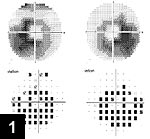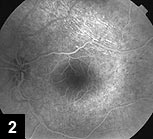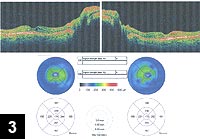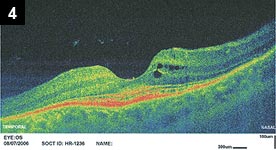Man experiences progressive loss of peripheral vision
Examination revealed crowded optic nerve heads, small cup-to-disc ratios and retinal thinning.

A 42-year-old man was referred to the neuro-ophthalmology clinic for evaluation of changes in his peripheral vision. He reported that for the past several years he had noticed increased difficulty with driving. In addition to having trouble seeing objects, he said that people would suddenly appear from the periphery. Although he had no accidents, this was causing him significant distress. His central vision was clear by history. He had no known history of ocular problems. He did not use tobacco products and would only occasionally drink alcohol. He had no known drug allergies and took no medications.
 Isabel M. Balderas |  Tom Hsu | ||
Examination
On examination, the patient’s best corrected visual acuity was 20/25 in each eye. There was no afferent pupillary defect. The extraocular muscle movements were full in each eye. Ocular alignment was orthotropic at distance and near. His color vision with AOHR plates was full in each eye. The exophthalmometry measurements were 23 mm in the right eye and 21 mm in the left eye, with an interpupillary distance of 98 mm. IOP was 12 mm Hg in each eye.
External examination revealed coarse facies. The conjunctivae in both eyes were white and quiet. Corneas were clear. The anterior chambers were deep and quiet. The lens had mild nuclear sclerotic changes consistent with the patient’s age. Posterior segment examination revealed crowded optic nerve heads, with small cup-to-disc ratios in each eye. The fundus examination was normal. Humphrey 30-2 static perimetry (Figure 1) in each eye showed symmetric ring-like scotomata. Fluorescein angiography (Figure 2) showed intact retinal vasculature and filling, with the presence of chorioretinal folds in both eyes. Optical coherence tomography (Figure 3) showed bilateral generalized thinning of the retinas, most pronounced in the 3- to 6-mm ring around the foveae. In addition, small foveal and parafoveal cystic spaces were seen in the inner retinas bilaterally.
 Humphery visual fields showing bilateral doughnut scotomata. |  Fluorescein angiography of the left eye at 48 seconds showing chorioretinal folds superotemporally. |  Optical coherence tomography showing retinal thinning and retinal cysts. Images: Yoon MK, Hedges TR |

What is your diagnosis?
Peripheral visual loss
This particular presentation can be difficult to narrow to a differential diagnosis. There are three useful findings in this patient that may be most pertinent.
First are the crowded optic nerve heads. This can be a normal finding in patients, which may increase the risk of ischemic optic neuropathy. Infiltrative diseases may cause this appearance, although the bilateral, symmetric appearance makes this less likely. This also holds true for optic disc drusen. Infectious causes may have a less uniform appearance with possible hemorrhages or exudates. The visual field is another finding with a unique appearance. This “doughnut”-like appearance is not often seen in organic disease. The patient had no history of taking hydroxychloroquine or any other medications that can cause visual field changes. Retinitis pigmentosa sine pigmento can cause a “ring” scotoma, although typically the scotomata are more peripheral. Finally, the cystic changes in the retinas were very small and did not alter the normal retinal contour. In addition, there was no leakage of dye on the fluorescein angiography.
The differential diagnosis of retinal cysts that do not leak includes forms of X-linked juvenile retinoschisis, some forms of retinitis pigmentosa, Goldmann-Favre disease and niacin deficiency. None of the other ocular or systemic findings of these conditions were seen on examination.
Based on these findings, none of the etiologies seemed to fit into a unifying diagnosis. Fortunately, the patient was able to provide additional historical information that revealed the diagnosis. The patient had been diagnosed with Hunter syndrome when he was 17 years old. His other systemic findings included short stature, bilateral progressive hearing loss, aortic valve insufficiency and hepatosplenomegaly. Diagnosis was made based on a skin biopsy that showed a deficiency of L-sulfoiduronate sulfatase, which is diagnostic of the condition. In addition, he had two maternal uncles with a presumptive diagnosis of Hunter syndrome.
Discussion
Hunter syndrome is an inherited lysosomal storage disorder, also known as mucopolysaccharidosis type II. This X-linked condition results from a deficiency in the enzyme iduronate 2-sulfatase, which leads to the accumulation of dermatan sulfate and heparan sulfate in all tissues of the body. The systemic findings include cardiac abnormalities, hepatosplenomegaly and progressive deafness. The condition has been classified into mild and severe forms, with the latter resulting in death by 35 years of age. Our patient had the milder form of the disease. Known ocular findings in Hunter syndrome include exophthalmos, hypertelorism and pigmentary retinopathy. Several histopathologic and electron microscopic reports show the loss of peripheral photoreceptors and migration of retinal pigment epithelium into the retina. Cystic accumulations of mucopolysaccharide have been found in many ocular structures, including the sclera, optic nerve, retina and ciliary body. Notably, the cornea does not have any infiltration on clinical examination.
 UHR-OCT of the left eye showing retinal cysts and loss of the inner segment-outer segment junction outside of the fovea. |
Our institution has a high-speed ultrahigh-resolution optical coherence tomography (UHR-OCT) machine with the ability to image the retina with a 3.5 µm axial resolution, compared with the 8- to 10-µm resolution of the Zeiss Stratus 3 OCT. This gave us greater resolution of the retinal changes (Figure 4). These included cystoids spaces in the ganglion cell layer, inner nuclear layer and outer nuclear layer in both eyes. These were presumed to be accumulations of mucopolysaccharides. Our patient’s visual field pattern with bilateral doughnut scotomata suggests a significant degree of photoreceptor loss in the extrafoveal macula with central sparing. This was also found in the UHR-OCT images with the loss of the inner segment-outer segment junction outside the fovea.
In July 2006, a medication, idursulfase, was approved as the first treatment of Hunter syndrome. This is a human enzyme replacement treatment that is given as weekly intravenous infusions. Although the patient did not elect to proceed with this treatment, it would be interesting to study if there is a correlation in the size and volume of retinal cysts with treatment response.
For more information:
- Michael K. Yoon, MD, and Thomas R. Hedges III, MD, can be reached at New England Eye Center, Tufts University School of Medicine, 750 Washington St., Box 450, Boston, MA 02111; 617-636-4219; fax: 617-636-4866; Web site: www.neec.com. Drs. Yoon and Hedges have no financial interest in the products mentioned in this article nor are they paid consultants for any of the companies mentioned.
- Edited by Isabel M. Balderas, MD, and Tom Hsu, MD. Drs. Balderas and Hsu can be reached at New England Eye Center, Tufts University School of Medicine, 750 Washington St., Box 450, Boston, MA 02111; 617-636-4219; fax: 617-636-4866; Web site: www.neec.com. Drs. Balderas and Hsu have no direct financial interest in the products mentioned in this article, nor are they paid consultants for any companies mentioned.
References:
- Abraham FA, Yatziv S, Russell A, Auerbach E. Electrophysiological and psychophysical findings in Hunter syndrome. Arch Ophthalmol. 1974;91(3):181-186.
- Anawis MA. Hunter syndrome (MPS II-B): A report of bilateral vitreous floaters and maculopathy. Ophthalmic Genet. 2006;27(2):71-72.
- Beck M, Cole G. Disc oedema in association with Hunter’s syndrome: Ocular histopathological findings. Br J Ophthalmol. 1984;68(8):590-594.
- Caruso RC, Kaiser-Kupfer MI, et al. Electroretinographic findings in the mucopolysaccharidoses. Ophthalmology. 1986;93(12):1612-1616.
- Chan A, Duker JS, et al. Normal macular thickness measurements in healthy eyes using Stratus optical coherence tomography. Arch Ophthalmol. 2006;124(2):193-198.
- Fujimoto JG, Huang D, et al. Physical properties of optical coherence tomography. In: Schuman JS, Puliafito CA, Fujimoto JG, eds. Optical Coherence Tomography of Ocular Diseases. 2nd ed. Thorofare, NJ: SLACK Incorporated; 2004:677-688.
- Goldberg MF, Duke JR. Ocular histopathology in Hunter’s syndrome. Systemic mucopolysaccharidosis type II. Arch Ophthalmol. 1967;77(4):503-512.
- Ko TH, Fujimoto JG, et al. Comparison of ultrahigh- and standard resolution optical coherence tomography for imaging macular pathology. Ophthalmology. 2005;112(11):1922.e1-15.
- McDonnell JM, Green WR, Maumenee IH. Ocular histopathology of systemic mucopolysaccharidosis, type II-A (Hunter syndrome, severe). Ophthalmology. 1985;92(12):1772-1779.
- Muenzer J, Wraith JE, et al. A phase II/III clinical study of enzyme replacement therapy with idursulfase therapy in mucopolysaccharidosis II (Hunter syndrome). Genet Med. 2006;8(8):465-473.
- Srinivasan V, Wojtkowski M, et al. High-definition and 3-dimensional imaging of macular pathologies with high-speed, ultrahigh-resolution optical coherence tomography. Ophthalmology. 2006;113(11):2054.e1-14.
- To K, Adamian M, Dryja TP, Berson EL. Retinal histopathology of an autopsy eye with advanced retinitis pigmentosa in a family with rhodopsin Glu181Lys. Am J Ophthalmol. 2000;130(6):790-792.
- Topping TM, Kenyon KR, Goldberg MF, Maumenee AE. Ultrastructural ocular pathology of Hunter’s syndrome. Arch Ophthalmol. 1971;86(2):164-177.
